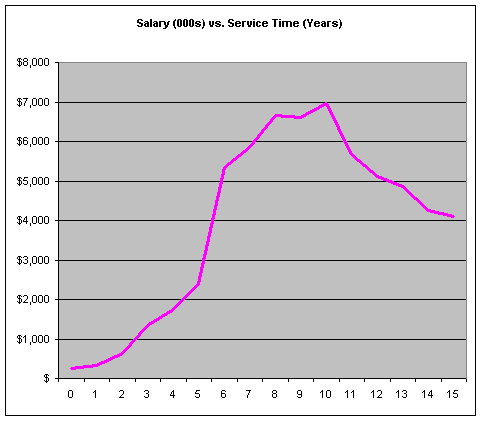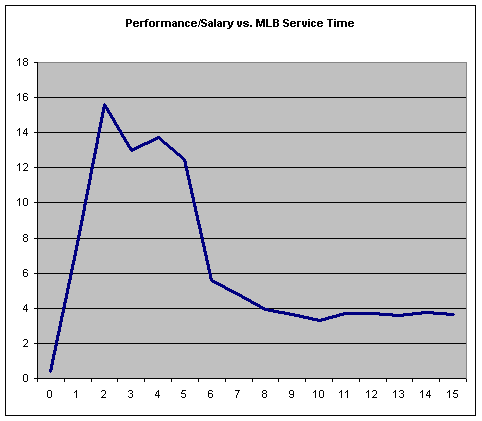Two weeks
ago, I asked readers to put themselves in the shoes of the management of the Kansas
City Royals, turn back the clock to about a week before
the Jermaine Dye
trade, and come up with suggestions on how to best run the franchise.
Last week,
I did my best to share the flavor and highlights of the copious responses we received.
(Bill James
wrote a piece in Rob Neyer’s space at ESPN this week
that basically says that this kind of exercise is so much narcissistic wheel-spinning.
Personally, I don’t like to miss an opportunity to waste time narcissistically.) This
week, I wanted to take a bit of time to outline what my action plan would be, given
the information available to the Royals at that point in time. So, without further
delay, here we go….
There are a number of obstacles between the Royals and consistent success on the field.
The Royals are not a comparatively wealthy franchise. In the near term, it’s not likely
that they will suddenly become so. Kansas City is not a large market by any stretch of
the imagination, and barring revolutionary revenue sharing in the new Collective Bargaining
Agreement (CBA), it is unlikely that the Royals are going to move into the top third of
clubs in terms of revenue generated by local broadcasts. Therefore, in order to compete
effectively on the field, the Royals need to be among the most efficient clubs in MLB in
terms of performance on the field per salary dollar spent.
That sounds like a desirable goal–sort of like a new strategy that "increases
revenue" and "reduces costs." But how do you get there?
The current CBA imposes a compensation structure that’s pretty straightforward:
- Clubs have renewal rights for all players with two years of experience or less,
and those with 2-3 years experience who are in the bottom 83% of service time within
that subcategory. The club can simply write out the contract, subject to the
restriction of the league minimum, and the player has no recourse other than to sit
out the season. - For those players with 2.83-5.99 years of experience (or thereabouts), the club
has the option to offer the player arbitration, or to simply release the player to
free agency. If the club chooses to offer arbitration, the player must either accept
arbitration, or sign a deal with the club that holds his rights. - Players with six or more years of service time are free agents, and may offer
their services to any club in MLB. Fun with the free market.
It’s not hard to forecast what player salaries end up looking like under this system.
(This graph is an example, and does not contain the actual data–it’s not that
important for a general discussion. I’m just trying to make a couple of points,
so bear with me.)

Players are cheap very early in their career, and then salaries escalate rapdily,
first because of arbitration, then free agency. "Damn the free market!"
— C. Montgomery Burns.
So that’s a broad sketch of the cost side of things. How about the performance side?
There are a number of different metrics out there for measuring the effectiveness
of players on the field. Pick the one with which you’re most comfortable. I simply
used an index and made up some relatively plausible sample data, which combines the
idea of a bell-shaped performance curve throughout a career, combined with the
Darwinistic/Actuarial nature of the game. (Again, the actual numbers should be
the subject of rigorous work, and for right now, that’s not really necessary to
grasp the concept.)

I’m cheating a little bit here for simplicity and clarity. Age, and not service time,
is really the driver here. This is for a player aggregate that joins the league around
22 or 23 years old, and peaks around 27 or so. The index on the left is simply an
analog for performance. You can choose
EqA,
OPS, RC27, WHiLMA, or whatever you want. Just focusing on the shape and trend here.
By now, you know what’s coming next. If you take a look at player cost, and the
cost for that player’s services, you end up with something that looks like this:

The sweet spot, in terms of return on your investment, is in the early years of a
player’s career. The numbers here really aren’t all the important, except to
demonstrate the dramatic extent to which the early years of a player’s
career are what the Royals need to buy into. Clubs with big revenue streams can
have a bit more diversity on their team in terms of players of different ages,
but the Royals really need to focus on having young players.
In all likelihood, this is going to be the key issue for the Royals going forward.
The structure of compensation isn’t likely to change, and revenue sharing simply
isn’t going to be the NFL model in the forseeable future.
So, if the club has a major weakness in terms of turning draft choices into
productive ballplayers (particularly on the hitting side), as we assumed in
the initial article, the performance index for players of that age coming from
the organization is going to be lower. How do we fix or get around that?
In the Long Term:
- Measure the effectiveness of the scouts and coaches more carefully.
Identify the good ones from your own organization, and pay what you need
to in order to keep them on board. Use objective measures, preferably
ones that allow you to compare your people with those from other
organizations. Make sure the metrics you use are directly relevant to
what makes a winning team at the MLB level. If good scouting or coaching
talent becomes available from other organizations, aggressively pursue it.
Invest the money here. - Promote players that do the things that win games. I know we praise the
Oakland A’s Way back and forth to Lubbock, but that’s because it works.
Reward players that do the things you want your major league players to do.
The A’s won’t give their Minor League Player of the Month award to a hitter
that doesn’t walk at least once every ten at bats. The reinforces the
notion that to get to the bigs, you have to get on base. The Royals need
to do this, and do it to improve behavior all across the spectrum, from
making measurable defensive improvements, to decreasing your time to the
plate. Over time, this works, and builds a culture that really does help. - Be a bastard organization. Don’t publicize it, but keep your players
in the minors a little bit longer. Give them a Mo Vaughn spelling lesson.
Yes, eventually, this might cost you some goodwill, but you can pick the
spots (long-term contract offers) where you can make it up to those players
who you really want to keep. I guess I should say this in English: Keep
your prospects in the minors a little longer, so you get the years closer
to their peaks at a lower price. Until the minor leagues are liberated,
this is the sort of relationship that’s going to exist, and the Royals
are faced with some serious resource constraints in a brutally competitive
environment. Another year of performance at pre-arbitration or pre-free
agency prices is a very valuable thing. Discretion is going to be
exceptionally important here, but it does need to be part of doing
business as usual.
In the Short Term:
- Go out and get low-priced, high risk talent. There are a number of
guys in the minors who might be able to perform well in the majors in one
role or another. A lot of these players can be had for a very low cost,
and if you stock up on a few of them, one or two will turn into players
with significant value that can be used either in trade, or as medium-term
contributors on a contending team. Guys like Cory Lidle, Chad Bradford,
Izzy Alcantara, and so on and so forth. Go get a few, give them
the opportunity to play, and try to hide their weaknesses as best you can.
You might be able to fill five MLB roster spots with championship-caliber
role players this way, and perhaps even come up with a starter or two. - Conserve cash. This is not a club that’s going to contend this year,
and isn’t likely to do so next year either. Take this as an opportunity
to save some cash, and experiment with the MLB playing time. Is
Kit Pellow notably worse than Joe Randa? He’s notably cheaper. - Identify two or three key young players, and offer them
Jim Thome/Omar Vizquel/Tim Hudson/Miguel Tejada
contracts. Lock them up. Mitigate your risk and theirs. It’s too late to
do that with Mike Sweeney (do you think he might have accepted a
seven-year, $14-million deal during his early seasons? I’m not just using
hindsight here–the club probably could have done something like that, and
it would have worked out well for all parties.), but something can probably
be worked out with Carlos Beltran, for example. You’ll hit some and
you’ll miss some, but the cost can be low, and the potential gain enormous.
This is all highly simplified. Obviously, you’ll want to be very careful
and rigorous in all your analyses. Player performance, coach and manager
performance, financial analysis, risk profiling — everything needs to be
done carefully if this is the real thing. But as a plan, I’m fairly
comfortable with this, at least if I get to stay in the GM’s chair. I’m
making assumptions all over place, but I’m writing a column, not a
business plan, and I don’t want to bore you silly with a bunch of academe.
(I’d rather bore you silly without doing the legwork.)
But there is one very big assumption that I need to make explicitly,
and from that flows everything else:
This plan assumes that the Kansas City Royal management will do the homework
required to better understand the basic tenets of what wins ballgames. They
need to have the epiphany that Life is OBP, and OBP is Life. They need to
protect their pitchers’ arms. They need to understand the effects of parks
and leagues on player performance. I honestly believe the biggest obstacle
between the Royals and consistent success is that Allard Baird really believes
that Neifi Perez is a great ballplayer, and that Tony Muser thinks that
slick glovework is more important than a great bat.
Despite all the work that’s been done in baseball analysis in terms of
developing the technology to evaluate performance, and all the work
transfering that technology into MLB front offices, there is still a very
long way to go. Royals fans still have many painful miles to walk, I fear.
I think Tony Muser and Allard Baird are dedicated professionals, and I have
a great deal of respect for the amount of effort they put forth in their
jobs. I also think they need to improve. Brian Cashman isn’t sitting still
in terms of learning, and neither is Billy Beane. Baird and Muser are
already behind, and facing challenges unique to their situation. That means
they need to work hard, work smart, and work now.
Gary Huckabay is an author of Baseball Prospectus. You can contact him by
clicking here.
Thank you for reading
This is a free article. If you enjoyed it, consider subscribing to Baseball Prospectus. Subscriptions support ongoing public baseball research and analysis in an increasingly proprietary environment.
Subscribe now